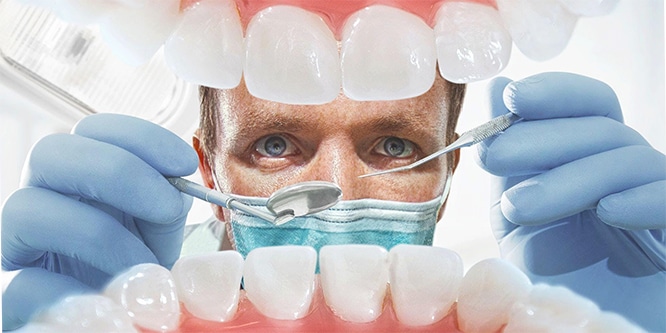Root canal treatment is an effective solution method for treating tooth infection and saving the tooth. It is performed when there is inflammation in the root of the teeth, and applied to save the teeth at risk. It is performed under local anesthesia, thus it is not a painful procedure. After infection-causing bacteria are cleared up during treatment, root canal is filled and the tooth is crowned. Canal treatment is usually performed by an endodontist or a dentist, on 2 or 3 appointments. It takes 1 hour on average. A root canal-treated tooth can be used for a lifetime, but may be more fragile than natural teeth. It is necessary to avoid hard or hot foods to prevent from damaging your sensitive teeth during and after the treatment.
Table of Contents
What is the root canal (endodontic) treatment?
Root canal treatment is performed to prevent the removal of a damaged or inflamed tooth, and to repair it. It is the process of clearing up the inflamed canals inside the tooth root and preserving the tooth. There exists a vascular-nerve tissue (pulp-tooth extract) inside the root. It nourishes the tooth extending from the top of the tooth (crown – the visible part of the tooth) to the tip of the tooth root. Pulp is the tissue responsible for the development and protection of the tooth and it is also the tissue giving the tooth vitality. (1)
Bacteria can enter in the tooth when it is cracked or has a deep dental cavity. Due to untreated tooth decay, the pulp gets inflamed and begins to die because of the bacteria infestation. As a result, the tooth is lost. With the root canal treatment, the inflamed tissue is cleared up, the root canal is shaped, cleaned and then filled with filling. Then, the tooth is crowned to maintain its full function and restore it.
Root canal treatment methods
The root canal system is filled with soft dental pulp. This pulp consists of nerves and blood vessels helping the tooth grow. Recovering a natural tooth in the event of a damage or inflammation is usually the best option. The root canal treatment is the treatment of choice.
Alternatives of root canal treatment are the removal of the damaged tooth and the replacement of it with a dental implant, bridge or removable partial denture. However, these procedures are more expensive than the root canal treatment. They usually require more time and additional procedures to treat surrounding teeth and tissues. (2)
What are the benefits of root canal treatment?
The root canal treatment protects the tooth and the bone around it, and this is the most important advantage of the root canal treatment. It is generally successful in killing the infection and rescuing the tooth. After the treatment, the tooth can normally function over the years. (3)
If left untreated, the infection inside the tooth can cause tooth loss. If it spreads to the ends of the root canal, it can erode the jaw bone (localized bone loss) or even become life-threatening. However, there is still a risk of recurring of the infection in the long term even though the correct treatment is administered.
Antibiotics used to treat bacterial infections are not effective in the treatment of the root canal infections. In some cases after the treatment, the tooth may become slightly discolored or yellow spots may appear on the inner surface of the tooth. However, it can be whitened by internal bleaching.
Precautions before root canal treatment
- If you feel swelling on your face and neck, toothache, abscess, gum swelling and tooth sensitivity, it may be an inflammatory condition. You must inform your dentist.
- Stop eating 1 hour before the procedure. Brush your teeth and rinse your mouth with an antiseptic mouthwash.
- If you have a chronic condition such as heart disease, diabetes, high blood pressure, and are taking medication, you must inform your dentist. Similarly, pregnant woman should also inform their dentist.
What are the steps of a root canal?
Before the treatment, an X-ray of the affected tooth is taken to clearly see the root canal and assess the level of damage. Next steps are as follows: (4)
- Firstly, local anesthesia is performed in damaged tooth and the patient does not feel the pain.
- Then, a plastic layer (dental dam) is placed around the tooth. The dam prevents you from swallowing the chemicals used during the procedure. It also protects the tooth from bacteria in saliva.
- Then, the tooth is opened from the top to access the tissue in the middle of the tooth.
- The decayed tooth is cleared up, and the inflamed tissue inside the root canals is removed. If there is an abscess, it is treated and the root canal is washed with solutions.
- Root canals are reshaped for better access during the filling phase.
- If the treatment needs to be performed in more than one visit, a small amount of medication is left in the root canal to kill the bacteria. A temporary filling is placed to protect the tooth.
- Antibiotics may be administered to help manage and prevent the infection.
- In the next visit, temporary filling and medication inside the tooth is removed. Root canal filling is placed. This closes the tooth and prevents reinfection.
- The final stage of root canal treatment is to restore the tooth. Without restoration, teeth with fillings break more easily than healthy teeth. The tooth is completely covered using a metal, porcelain or ceramic crown to protect and restore its full function.
Root canal treatment aftercare
- Your restored tooth may be sensitive for several days. You can take over-the-counter painkillers such as paracetamol or ibuprofen to relieve any discomfort. Call your doctor if you still have pain or swelling after using a painkiller.
- It is recommended not to eat for several hours until the numbness in your mouth wears off. This prevents you from biting your tongue or cheek.
- Do not eat hard or hot foods that can damage your teeth during and immediately after the treatment. Try to eat soft foods like applesauce, yogurt, eggs, and fish.
- To protect your dental health, do not eat too much food high in sugar. You should quit smoking.
- After the root canal treatment, attention should be paid oral hygiene. Brush your teeth regularly and use dental floss. Do not skip your dentist visits.
- It is important to use the other part of the chin until permanent filling is made. Temporary fillings can easily break even when they become rigid, and they can damage the surrounding teeth tissue.
- Avoid biting or chewing with the treated tooth until it is restored.
How long does root canal treatment take?
Depending on the condition of the tooth, the root canal treatment can take between 1-3 visits. For an infected tooth, several visits may be required to completely eliminate the infection.
An uncomplicated root canal treatment is usually completed in a single visit. Infected dental pulp is removed in the first visit. In the second or third visit, the root canal is cleared up, filled and crowned. Each visit takes about 90 minutes. Drugs can be placed in the root canal to kill the bacteria. This is done when there is inflammation at the root tip.
In order for this drug to be effective, it is necessary for the drug to remain in the canal for at least 5–7 days. During this time, the tooth is covered with temporary filling.
From what age can root canal treatment be done?
In children, it is necessary to preserve milk teeth in front area up to 6-8 years old, and the ones in back area up to 12 years old. During this period, if there are cavities in the milk teeth, they are filled. If inflammation develops and cavity enlarges, the root canal treatment is required. (5)
Pain after root canal treatment
There may be mild pain or sensitivity in chewing for the first few weeks after the treatment. Your tooth may be more sensitive, especially if there is pain or infection before the procedure. This condition can be resolved with over-the-counter or prescription drugs.
If the pain continues, the root canal filling may be incomplete or insufficient. In this case, a process called retreatment is performed. In this process, the root canal filling is removed, and then the root canal is cleared up and refilled. If this treatment gives no results, tooth can be treated with a surgical method called root tip resection.
Prices of root canal treatment
The cost of the root canal treatment varies depending on how much the tooth is affected. Most of the dental insurances partly cover endodontic treatment. In general, endodontic treatment and restoration of natural teeth are cheaper than tooth removal.
The removed tooth should be replaced with an implant or bridge to restore the chewing function and prevent the adjacent teeth from shifting. These procedures cost more than the endodontic treatment and proper restoration.
Complications of root canal treatment
- A tooth with root canal treatment is carved to a certain degree. Therefore, it is more prone to fracture. Sometimes there may be an undetected crack at the time of treatment. The tooth may need to be removed even if it is successfully treated with the root canal treatment.
- The success of a properly performed root canal treatment is above 90% -95% on average. Sometimes, excessively curved roots cause the root canal device to break in the root canal or the root canals cannot be completely cleared up. In this case, the root canal treatment is performed again. If it is not successful, surgical methods are used to save the tooth.
- In some cases, it becomes difficult to find the root canal due to tightness or degeneration. The tooth can be accidentally drilled trying to locate the root canal. Many holes can be repaired, but if it is severe, the tooth may need to be removed.
- Most teeth can be treated. If the canals are not accessible, the root is severely broken or the tooth does not have sufficient bone support, the tooth cannot be saved. Endodontic surgery saves the tooth when endodontic treatment is not effective.
- Waiting too long to receive root canal treatment can often lead to tooth and bone loss. It may be too late for the root canal treatment in a tooth with severe furcation (the area located between the roots in multi-rooted tooth), and tooth removal may be required.
- A tooth that continues to break below the root or along a significant part of the top of the tooth will continue to hurt or become infected even after the root canal treatment.
- If there is not enough healthy tooth structure on the bone for the crown, the root canal treatment is unnecessary. Sometimes, a crown lengthening procedure can be applied to have the bone exposed more. A careful examination by a restoration specialist should be performed to determine the disadvantages of such a procedure, and the situation should be evaluated.
- Third molars or wisdom teeth are generally not functional. Instead of protecting them with the root canal treatment, they should be removed.
- During the procedure, the tooth root may crack. The tools may break in the root canal or drill it. This makes it difficult to effectively fill the tooth.




